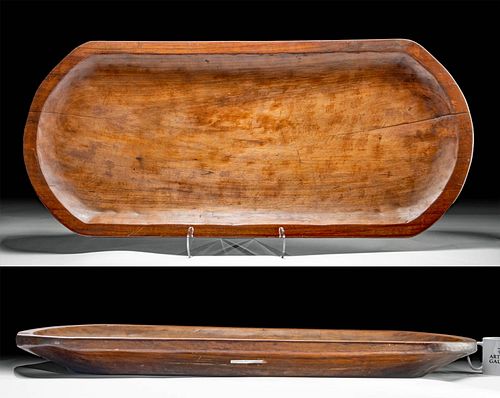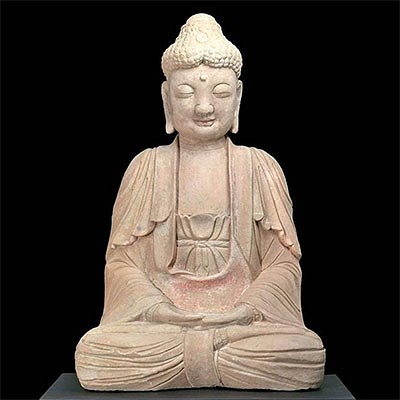20th C. Hawaiian Koa Wood Pig Platter
Lot 144
About Seller
Artemis Fine Arts
686 S Taylor Ave, Ste 106
Louisville, CO 80027
United States
Selling antiquities, ancient and ethnographic art online since 1993, Artemis Gallery specializes in Classical Antiquities (Egyptian, Greek, Roman, Near Eastern), Asian, Pre-Columbian, African / Tribal / Oceanographic art. Our extensive inventory includes pottery, stone, metal, wood, glass and textil...Read more
Categories
Estimate:
$2,000 - $3,000
Absentee vs Live bid
Two ways to bid:
- Leave a max absentee bid and the platform will bid on your behalf up to your maximum bid during the live auction.
- Bid live during the auction and your bids will be submitted real-time to the auctioneer.
Bid Increments
| Price | Bid Increment |
|---|---|
| $0 | $25 |
| $300 | $50 |
| $1,000 | $100 |
| $2,000 | $250 |
| $5,000 | $500 |
| $10,000 | $1,000 |
| $20,000 | $2,500 |
| $50,000 | $5,000 |
| $100,000 | $10,000 |
| $200,000 | $20,000 |
About Auction
By Artemis Fine Arts
Feb 18, 2021
Set Reminder
2021-02-18 10:00:00
2021-02-18 10:00:00
America/New_York
Bidsquare
Bidsquare : Exceptional Antiquities, Asian, Ethnographic
https://www.bidsquare.com/auctions/artemis-gallery/exceptional-antiquities-asian-ethnographic-6373
Museum-worthy examples of Egyptian, Greek, Roman, Etruscan, Near Eastern, Far East / Asian, Pre-Columbian, African / Tribal, Oceanic, Native American, Spanish Colonial, Russian, Fossils, Ancient Jewelry, Fine Art, so much more! Artemis Fine Arts info@artemisfinearts.com
Museum-worthy examples of Egyptian, Greek, Roman, Etruscan, Near Eastern, Far East / Asian, Pre-Columbian, African / Tribal, Oceanic, Native American, Spanish Colonial, Russian, Fossils, Ancient Jewelry, Fine Art, so much more! Artemis Fine Arts info@artemisfinearts.com
- Lot Description
North Pacific, Hawaii, ca. early 20th century. An impressive and quite sizable platter finely carved from koa wood of an ovoid form. Intended to hold a kalua pig (a pig that has been roasted in an underground oven), this huge dish features a flat base with thick walls that rise gently upwards. The tropical piece's smooth surface boasts a gorgeous natural woodgrain in swirling hues of caramel and butterscotch with chocolate brown striations. Size: 21" W x 47.125" H (53.3 cm x 119.7 cm)
Hawaiian wood dishes, such as this example, were used for serving and storing poi, salting and serving meat, and storing tapa cloth and feathers. It is possible that this dish would have been used at a luau feast, which takes its name from the Hawaiian word for the taro leaf that resembles roasted spinach once steamed for a few hours. The Hawaiian luau began in 1819 when King Kamehameha II removed the religious kapu (taboo) system that restricted women and commoners from eating delicacies and women from eating with men. To introduce the people to this new system, the king performed a symbolic act by inviting women to dine with him, thereby hosting the first luau. The luau feast is traditionally eaten by hand and served on floor mats decorated with large centerpieces made of ti leaves.
According to the Hearst Museum of Anthropology at University of California, Berkeley, "Carvers preferred the wood of the koa (or kou) tree because its grain was relatively soft and easy to cut. Food bowls were carefully carved from hardwoods with stone and later metal tools; some were also hollowed out with fire. Next, the bitterness in the wood was removed by soaking in sea water; the wood was further sweetened by an application of fermented taro or sweet potato. Finally, the bowl was polished with pumice or shark skin, and rubbed to a high gloss with nut oil. This coating helped waterproof the wood, extending its life."
Provenance: private Newport Beach, California, USA collection
All items legal to buy/sell under U.S. Statute covering cultural patrimony Code 2600, CHAPTER 14, and are guaranteed to be as described or your money back.
A Certificate of Authenticity will accompany all winning bids.
We ship worldwide and handle all shipping in-house for your convenience.
#161972Vertical stable fissure on both sides. Expected surface wear with light nicks and abrasions as shown. Otherwise, excellent with nice patina.Condition
- Shipping Info
-
All shipping is handled in-house for your convenience. Your invoice from Artemis Gallery will include shipping calculation instructions. If in doubt, please inquire BEFORE bidding for estimated shipping costs for individual items.
-
- Buyer's Premium



 EUR
EUR CAD
CAD AUD
AUD GBP
GBP MXN
MXN HKD
HKD CNY
CNY MYR
MYR SEK
SEK SGD
SGD CHF
CHF THB
THB
















